This was published 4 years ago
A look through the lens at Hong Kong's summer of protest
The protests have changed the city and the global public's perception of the fight for democracy. Here is how the demonstrations have unfolded.
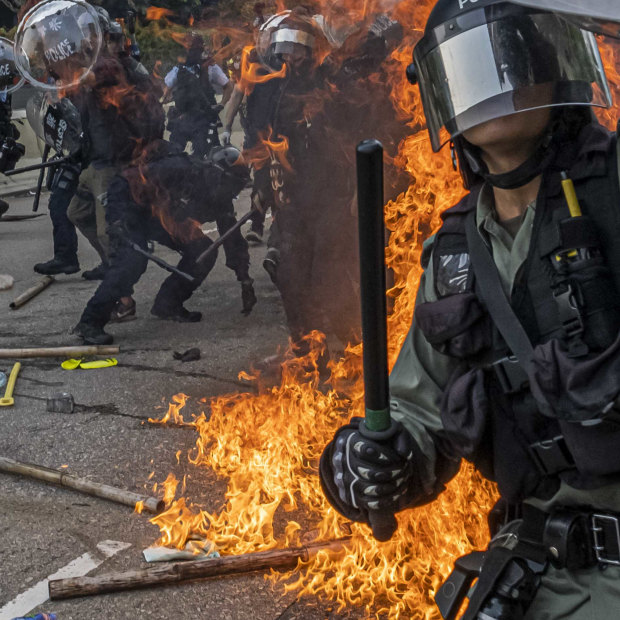
Hong Kong has endured a summer of discontent.Credit: The New York Times
It was the biggest protest turnout in Hong Kong’s history, and it caught the world by surprise. A million Hong Kong people marched on June 9, in a city with a population of 7 million.
The march was peaceful and slow, and the protesters crossed generations – families with babies in prams, the elderly, the young. They wanted Carrie Lam’s government to withdraw a controversial extradition bill that many Hong Kong people feared would allow political dissidents and business people to be sent to mainland China to face the communist legal system.
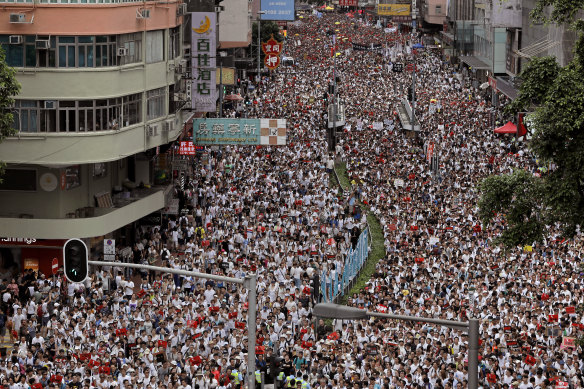
Protesters to an extradition law march in Hong Kong at the start of a season of discontent on June 9, 2019.Credit: AP
On the 22nd anniversary of Hong Kong’s handover to China on July 1, a small group of protesters stormed the Legislative Council late at night, smashing glass windows, defacing the chamber and waving the colonial flag. They read out five demands: The withdrawal of the extradition bill, an inquiry into police violence against protesters, amnesty for arrested protesters, the removal of the 'riot' label, and universal suffrage.
Earlier, a crowd of 500,000 had marched in the streets. Police surrounding the Legislative Council withdrew from the building for several hours at night, prompting pro-democracy politicians to accuse police of a “trap”. Carrie Lam held a 4am press conference to say she was shocked.
The expectation was that public support for the protesters would be lost - but this doesn’t happen. A graffiti message left in the Legislative Council read: “It was you who taught me peaceful protest is futile.”
As the parliamentary chamber was sacked, one protester removed his mask in front of television cameras to declare “Hong Kongers already have nothing to lose”. He was later identified as Brian Leung, 25. Facing a potential jail term of 10 years, he fled the city. Leung was among a delegation of Hong Kong activists who travelled to Washington last week to call for support for the Hong Kong protesters.
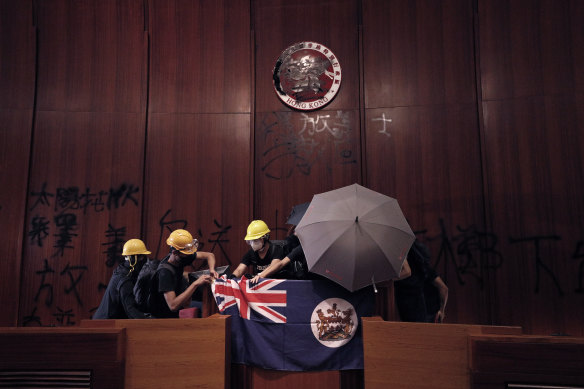
Protesters with a colonial-era flag storm Hong Kong's Legislative Council on July 1.Credit: AP
There were surreal scenes as riot police rush into a glossy shopping mall in Sha Tin, firing pepper spray beneath the designer logos. Protesters, shoppers and police with batons slipped on white floors drenched with pepper spray and streaks of blood. Forty people were arrested and 28 hospitalised. Protesters had entered New Town Plaza to get to the adjoining train station to leave an authorised march. But trains were halted, leaving them stranded.
A week later, on July 21, there were worse scenes. White-shirted thugs wielding canes rushed into the Yuen Long station and onto train carriages to beat passengers. Police didn't arrive for 39 minutes. Some of the men in white were later identified as Triad members, and some were photographed shaking hands with pro-Beijing lawmaker Junius Ho.
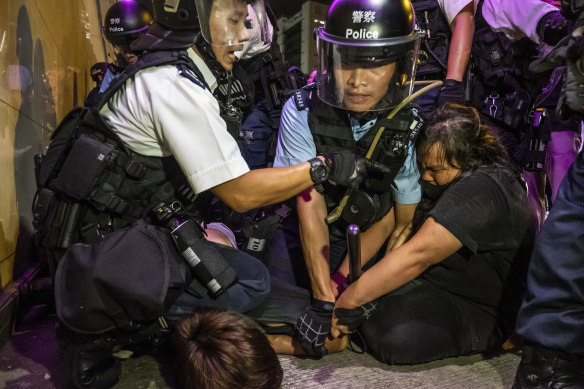
Police officers mark arrests in the Sha Tin district of Hong Kong, July 14, 2019Credit: The New York Times
School students gathered in Edinburgh Place in Central on August 22, and declared they would boycott classes when school and university were due to return for the start of the academic year on September 2. At that point, the protests lasted longer than the 79 day Umbrella Movement of 2014 which had brought Hong Kong’s city centre to a standstill. By contrast, the extradition bill protests had ranged far and wide, from the city business district to its outlying suburbs in the New Territories. Tactics follow the motto “Be Water”.
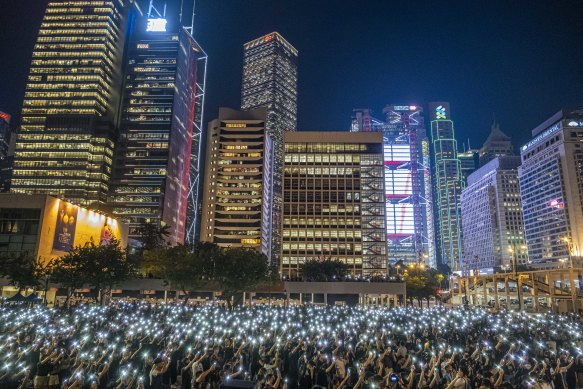
A rally of students in support of anti-government protesters in the Central district of Hong Kong, August 22, 2019. Credit: The New York Times
Tensions escalated after the Mass Transit Rail (MTR) Corporation announced it would shut four train stations nearest to an authorised protest at Kwun Tong on August 24. Hong Kong residents rely on MTR to move around the city, and many apartments and shopping malls were above MTR stations. But MTR had been attacked by Chinese state media a day earlier, accused of being an “accomplice to rioters” by allowing protesters onto its trains.
The Kwun Tong march descended into violence at Kowloon Bay as bamboo poles and petrol bombs were thrown on a road by protesters, and riot police fired tear gas. The scenes ended a week of calm after a march by an estimated 1.7 million residents the previous Sunday repeated the call for the extradition bill to be formally withdrawn and an independent inquiry into police conduct held.

Protesters clash with police officers in Kowloon Bay in Hong Kong, August 24, 2019. Credit: The New York Times
Black clad special forces “raptors” stormed through a train carriage at Prince Edward MTR wielding batons and pepper spray late in the evening of August 31.
Video footage of passengers cowering on the ground inside a train carriage, huddling and hugging each other, shocked the Hong Kong public.
The MTR station closed as 53 people were arrested. Seven were seriously injured and required hospitalisation, yet ambulance services were initially refused entry to the platform by police and there was a two hour delay in transporting them to hospital.
A revision in the number of injured, from 10 to seven, by ambulance staff fuels rumours that three protesters died. The Hong Kong government repeatedly denied any deaths. MTR was ordered by the High Court to retain CCTV footage of Prince Edward station from August 31 as passengers caught in the chaos took legal action against police use of force.
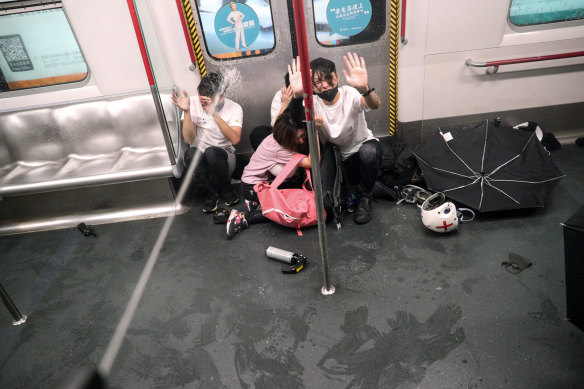
Police shoot pepper spray at protesters inside a train at Prince Edward Station, in Hong Kong, August 31, 2019.Credit: AP
A protester used a street sign as a shield as police charged barricade lines in the Causeway Bay shopping district on August 31. Protesters lit fires in the road to impede charging riot police, providing spectacular photographs for the media that followed closely behind. Protesters threw Molotov cocktails and police deployed a new water cannon, tear gas and rubber bullets outside the Sogo department store. Police fired live shots at nearby Victoria Park after demonstrators chased away an undercover policeman dressed as a protester.
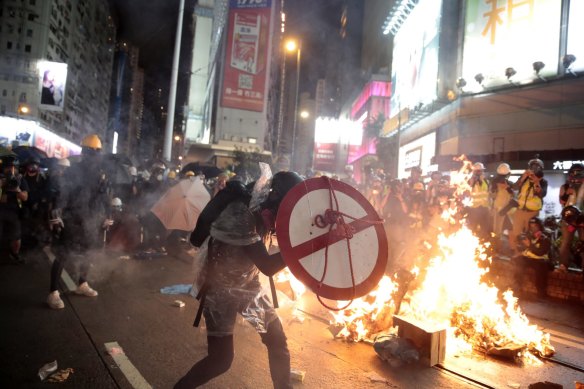
A protestor uses a shield to cover himself as he faces police in Hong Kong, Saturday, August 31, 2019. Credit: AP
A woman held a cross in front of the Mongkok Police Station as riot police held shields stood guard on September 1. There was public anger at the actions of riot police who ran through a train carriage with batons and used pepper spray at nearby Prince Edward MTR station the night before. For the next week, protesters continued to gather at Mongkok to lay white flowers and demand answers from police on what happened inside Prince Edward MTR.
As violence has escalated, Christian church volunteers, many elderly, took to the streets and put their frail bodies between charging police and fleeing protesters. They said they want to protect the children.
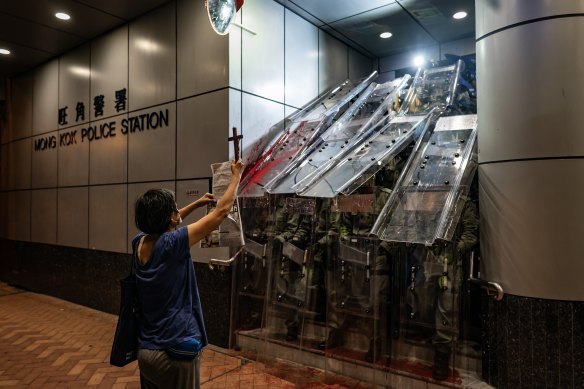
A woman holds a cross in front of the Mongkok Police Station as riot police holding shields stand guard during a standoff with protesters after an anti-government rally in on September 1, 2019 in Hong Kong.Credit: Getty Images
Chief Executive Carrie Lam makes a key concession to protesters, formally withdrawing the controversial extradition bill after 13 weeks of protests that resulted in 1183 arrests. Lam made the announcement in a pre-recorded televised address after meeting with pro-Beijing politicians at Government House.
Lam said the protests showed "discontent extends far beyond the bill" and said she wanted to start a dialogue with the public. But Lam did not agree to hold an independent inquiry into police conduct – a second major protest demand.
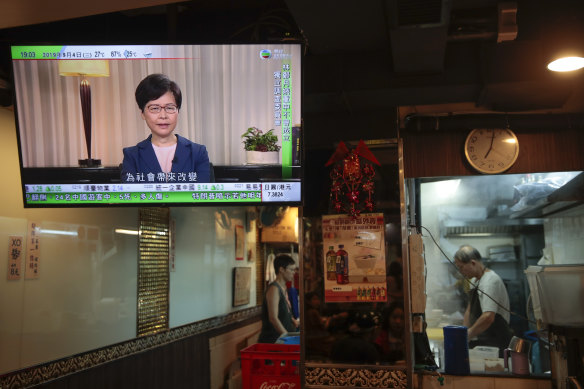
Hong Kong Chief Executive Carrie Lam makes an announcement on an extradition bill in television message, seen at a restaurant in Hong Kong, on Wednesday, September 4, 2019Credit: AP
Pro-Beijing protesters and democracy protesters fought at Amoy Plaza in Kowloon Bay on Saturday, September 14. The brawling erupted after a week where rival groups gathered in shopping malls to sing. The democracy protesters adopted the Cantonese song Glory to Hong Kong as their anthem.
The pro-Beijing groups sang the Chinese national anthem, March of the Volunteers, in Mandarin. Media covering the Amoy Plaza scuffles noted that only black clad democracy protesters were arrested by police.
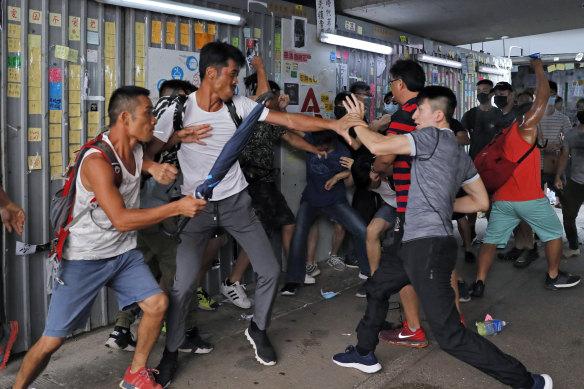
A group of pro-police supporters fight with an anti-government protester, right, outside the Amoy Plaza in the Kowloon Bay district in Hong Kong, Saturday, September 14, 2019. Credit: AP
Water cannons fired blue stained water at protesters outside the government offices in Hong Kong on Sunday September 15. Tens of thousands of protesters defied a police ban to march from Causeway Bay to Central. MTR stations are vandalised. The youngest protester arrested on the Sunday was 13 years old.
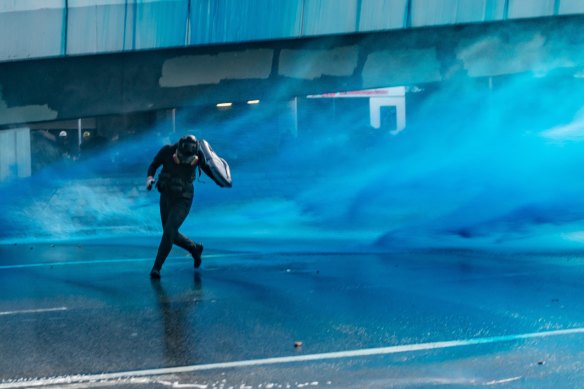
Pro-democracy protesters react as police fire water cannons at them outside the Central Government Complex on September 15, 2019 in Hong Kong.Credit: Getty Images
Pro-democracy slogans were spray painted across a billboard. Hong Kong chief executive Carrie Lam said she would hold a community dialogue session on Thursday September 26 in a sports stadium, in an attempt to solve the political crisis in Hong Kong. The session was intended to reach out to “people from all walks of life … so as to fathom the discontent in society” her office said. A computer randomly selected 150 people to attend who had registered online.
After 15 weeks of protests, credit rating agency Moody’s downgraded its outlook for Hong Kong from stable to negative. Moody’s cited “an erosion in the strength of Hong Kong’s institutions”. By June nearly 1500 protesters had been arrested.
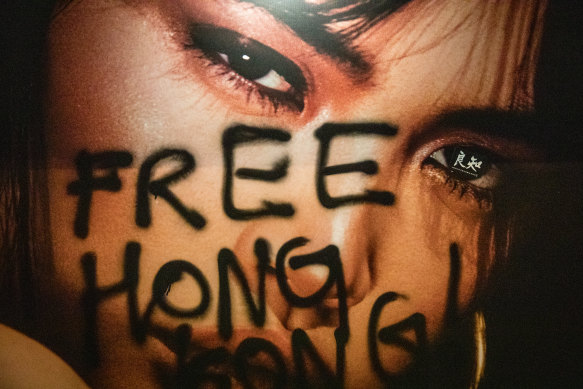
Pro-democracy posters and slogans are seen on an advertising board in the aftermath of protests on September 16, 2019 in Hong Kong.Credit: Getty Images
Protesters would sometimes hold a hand over one eye in a gesture that symbolises the first aid volunteer hit in the eye by a suspected police bean bag round. The young woman, who fought a High Court case to stop police using her medical records, was at the time still recuperating and became an icon of the protest movement. The incident had occurred on the streets of the once popular tourist shopping district of Tsim Sha Shui one evening. Volunteer medics, often university medical students or nurses, had been among those arrested by police in a crackdown on protests.
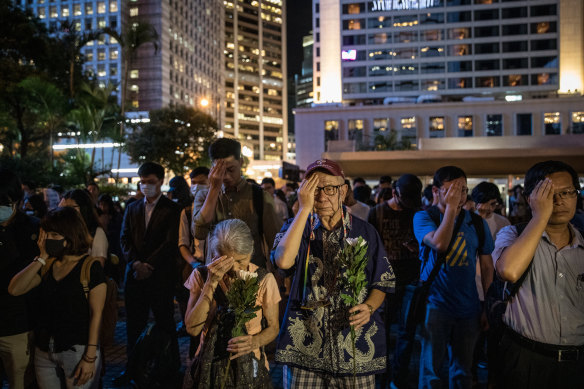
Protesters cover their left eyes and stand in silence during the 74th Liberation Anniversary Assembly on August 30, 2019 in Hong Kong.Credit: Getty Images